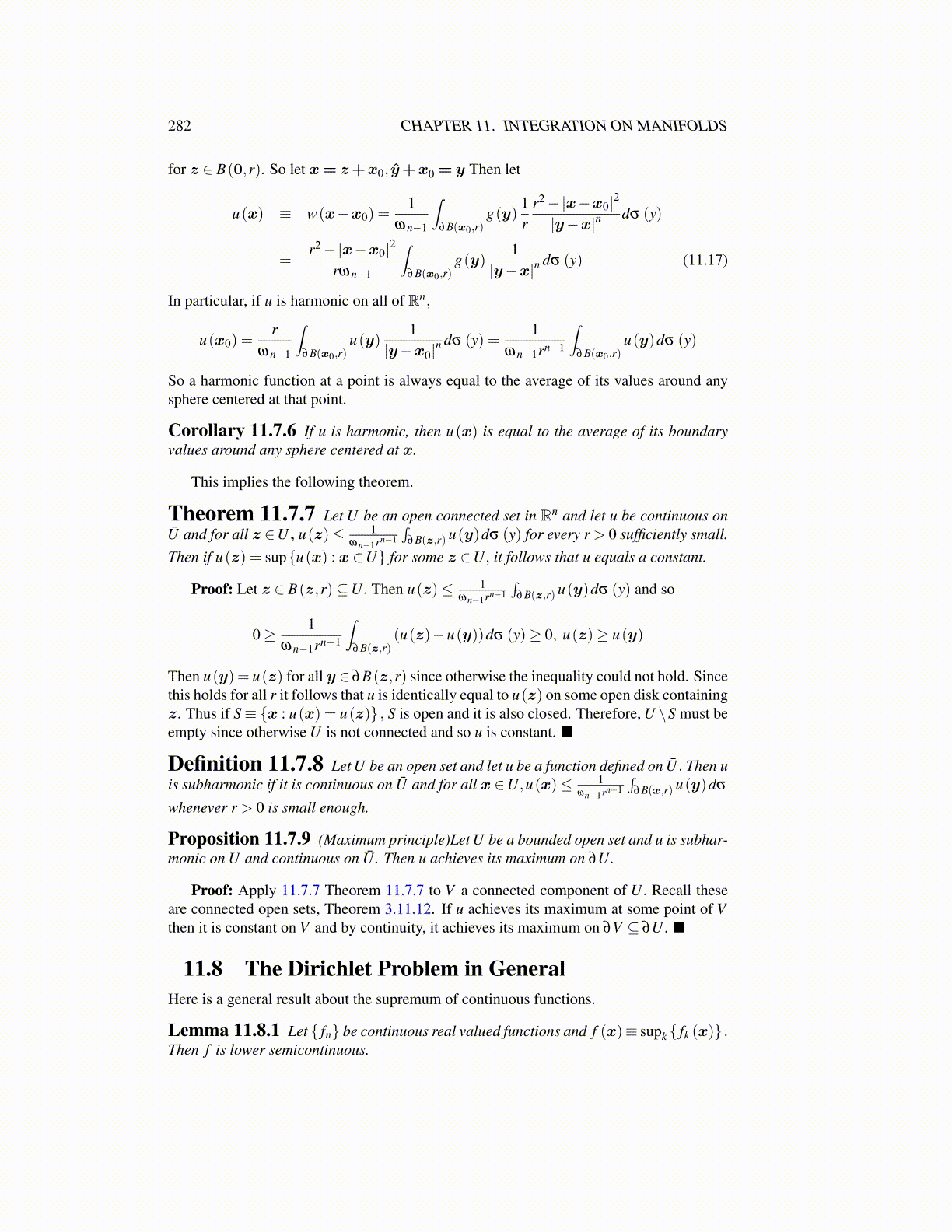
282 CHAPTER 11. INTEGRATION ON MANIFOLDS
for z ∈ B(0,r). So let x= z+x0, ŷ+x0 = y Then let
u(x) ≡ w(x−x0) =1
ωn−1
∫∂B(x0,r)
g(y)1r
r2−|x−x0|2
|y−x|ndσ (y)
=r2−|x−x0|2
rωn−1
∫∂B(x0,r)
g(y)1
|y−x|ndσ (y) (11.17)
In particular, if u is harmonic on all of Rn,
u(x0) =r
ωn−1
∫∂B(x0,r)
u(y)1
|y−x0|n dσ (y) =
1ωn−1rn−1
∫∂B(x0,r)
u(y)dσ (y)
So a harmonic function at a point is always equal to the average of its values around anysphere centered at that point.
Corollary 11.7.6 If u is harmonic, then u(x) is equal to the average of its boundaryvalues around any sphere centered at x.
This implies the following theorem.
Theorem 11.7.7 Let U be an open connected set in Rn and let u be continuous onŪ and for all z ∈U, u(z)≤ 1
ωn−1rn−1
∫∂B(z,r) u(y)dσ (y) for every r > 0 sufficiently small.
Then if u(z) = sup{u(x) : x ∈U} for some z ∈U, it follows that u equals a constant.
Proof: Let z ∈ B(z,r)⊆U. Then u(z)≤ 1ωn−1rn−1
∫∂B(z,r) u(y)dσ (y) and so
0≥ 1ωn−1rn−1
∫∂B(z,r)
(u(z)−u(y))dσ (y)≥ 0, u(z)≥ u(y)
Then u(y) = u(z) for all y ∈ ∂B(z,r) since otherwise the inequality could not hold. Sincethis holds for all r it follows that u is identically equal to u(z) on some open disk containingz. Thus if S≡ {x : u(x) = u(z)} , S is open and it is also closed. Therefore, U \S must beempty since otherwise U is not connected and so u is constant. ■
Definition 11.7.8 Let U be an open set and let u be a function defined on Ū . Then uis subharmonic if it is continuous on Ū and for all x ∈U,u(x)≤ 1
ωn−1rn−1
∫∂B(x,r) u(y)dσ
whenever r > 0 is small enough.
Proposition 11.7.9 (Maximum principle)Let U be a bounded open set and u is subhar-monic on U and continuous on Ū. Then u achieves its maximum on ∂U.
Proof: Apply 11.7.7 Theorem 11.7.7 to V a connected component of U. Recall theseare connected open sets, Theorem 3.11.12. If u achieves its maximum at some point of Vthen it is constant on V and by continuity, it achieves its maximum on ∂V ⊆ ∂U . ■
11.8 The Dirichlet Problem in GeneralHere is a general result about the supremum of continuous functions.
Lemma 11.8.1 Let { fn} be continuous real valued functions and f (x)≡ supk { fk (x)} .Then f is lower semicontinuous.